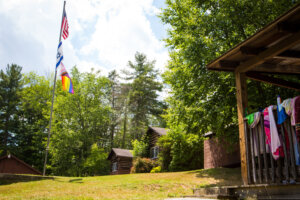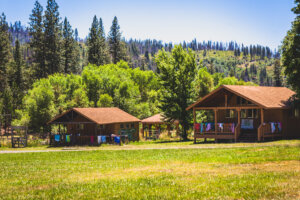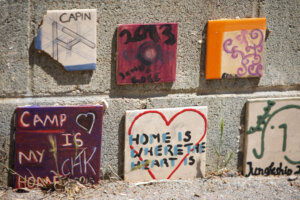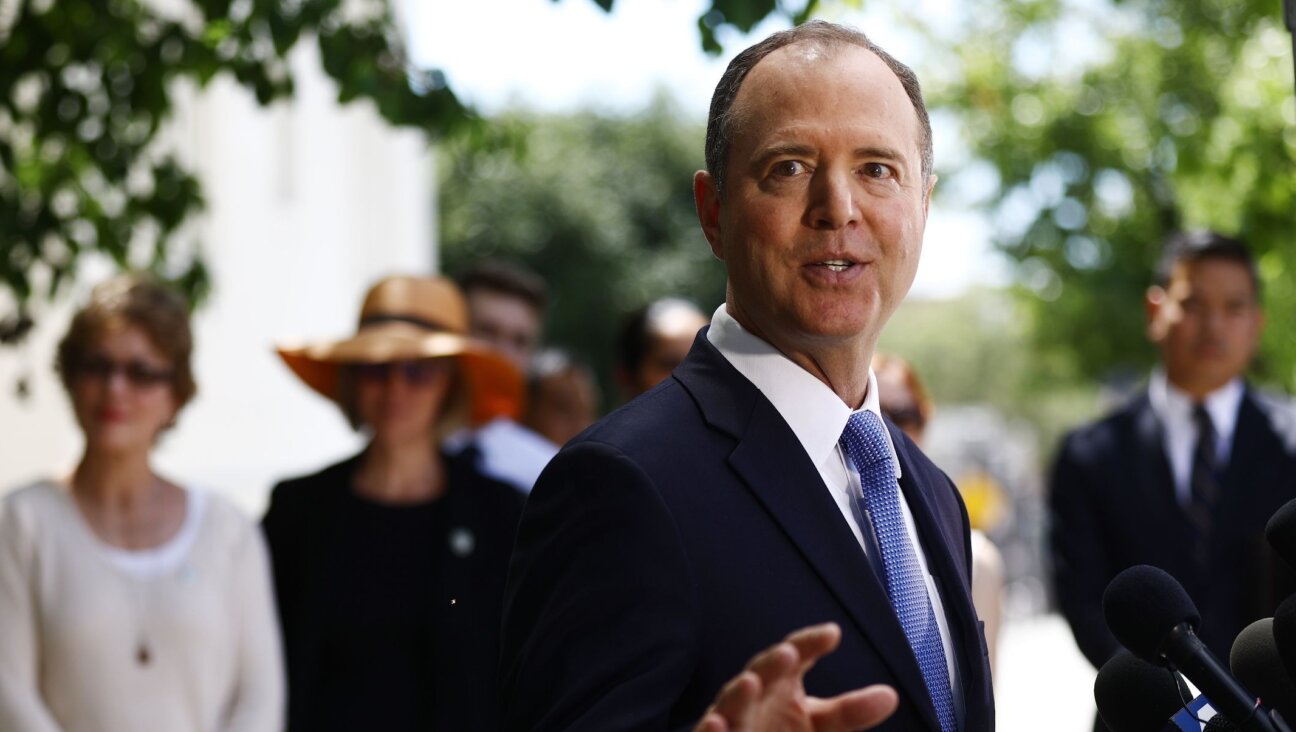At Jewish sleepaway camps this summer, bunks and bathrooms accommodate any gender identity
Increasingly at non-Orthodox camps, there isn’t simply a boys side and a girls side

Directional signs at Camp Hess Kramer in California. Photo by Alisha Jucevic/Bloomberg via Getty Images
When her children were old enough for sleepaway camp, Laura Strashny planned to send them to Camp Ramah of New England. But after the Massachusetts camp, which is affiliated with the Conservative movement, began allowing trans kids to bunk with the gender they identify with, the Strashny kids went to Orthodox camps instead. Strashny called the policy a “nonstarter.”
But that approach is increasingly becoming the norm. Meeting a reality in which 1 in 5 teens identifies as LGBTQ+ and about 1.4% of teens identify as trans, scores of Jewish camps — 90 out of 153 Jewish overnight camps nationwide — say they welcome transgender and nonbinary (TNB) campers, according to the Foundation for Jewish Camp’s Find A Camp tool. A Foundation for Jewish Camp executive said the majority of those allow trans and nonbinary campers to choose the bunk that best fits them.
Listen to That Jewish News Show, a smart and thoughtful look at the week in Jewish news from the journalists at the Forward, now available on Apple and Spotify:
“Jewish camps in general are probably amongst the most welcoming, affirming spaces that exist for trans campers,” said Rabbi Daniel Bogard, who founded a nonsectarian camp for LGBTQ+ youth and teens and who helps train Jewish camp staff on TNB sensitivity.
The same approach that led Strashny to Orthodox camps drove Matan Bauman away from them. Bauman, who is gay, grew up at a modern Orthodox camp in Pennsylvania. He found it stifling — so he stopped working there and joined the staff at Ramah instead.
“Within the LGBTQ community, there’s not really space for us” at Orthodox camps, Bauman said.
While most people choose their camp based on other factors, a camp’s approach to TNB kids is of prime importance for an increasing number of Jewish families. No Orthodox camp allows trans kids to bunk by gender identity, several Jewish camp professionals said, and for some parents like Strashny — and for Orthodox families with trans and nonbinary children — that distinction makes their choice.
Still, not every non-Orthodox camp is a welcoming space for TNB campers — Bogard drew a distinction between camps that “accommodate” and those that “welcome” them. And while Orthodox camps may not be hospitable for TNB kids right now, some have moved toward queer acceptance in ways that may have seemed inconceivable a decade ago.
In the weeks before families of some 70,000 Jewish sleepaway campers started labeling bathing suits and socks, the Forward spoke to camp directors, staff and families, as well as national and local support staff, to learn how Jewish camps across the religious spectrum are meeting this moment of growing gender diversity.
Of non-Orthodox Jewish sleepaway camps, many are associated with the Reform movement and Ramah, a group of camps affiliated with Conservative Judaism. Union of Reform Judaism camps assign staff and campers to housing based on their gender identity and what campers and their families recognize as most affirming for them, a spokesperson said. Ramah has a broadly inclusive national policy but allows each camp to set their own rules. The Reconstructionist movement has only Camp Havaya, which was at the forefront of embracing LGBTQ+ campers and counselors. And of the independent camps that don’t yet bunk by gender identity, many have taken steps toward TNB inclusion, such as training staff on language and sensitivity.
Camps Tel Yehuda, the flagship camp of Young Judaea, a Zionist movement which runs several overnight and day camps in the U.S., did not return requests for comment.
Some declined to participate on the record, citing friction within their communities and pressure from beyond them. Ramah was the subject of a harassment campaign last year after Libs of TikTok, an anti-trans social media account, posted about its trans inclusion policy. But several shared that trans and nonbinary staff and campers were a regular element of camp life, even as the camp was still working to make them more comfortable.

‘An evolution’
Across non-Orthodox denominations, Jewish summer camps have created bunks and other affirming spaces for nonbinary campers, adopted policies to meet the needs of trans campers and worked to de-gender language in everyday contexts.
Five years ago, most Jewish camps did not have a plan for trans kids at all. The shift has been as rapid as it was quiet.
Habonim Dror’s Camp Moshava introduced an all-gender bunk in 2017; two years later, Camp Tawonga, an overnight camp near Yosemite National Park, followed suit. A third bunking option is far from the norm at Jewish camps today — only a handful now offer it — but several camp directors said they would if they had enough kids to fill one.
Accompanying these high-level policy shifts are more subtle changes designed to make life easier for trans and nonbinary campers. Camp Alonim, an unaffiliated overnight camp in Southern California, launched a special gathering space for transgender and nonbinary campers last summer. Camp Ramah in New England, which is in Western Massachusetts, added more all-gender bathrooms this year.
And a few years ago, a packing list at Camp Ramah in California that once recommended boys bring button-downs and slacks or shorts and girls bring dresses for Shabbat was edited to instruct all campers to bring two Shabbat outfits, which could be any of the above.
“It’s very different based on location of the camps and based on the community that they’re serving,” said Jamie Simon, a Foundation for Jewish Camp executive. “And the more progressive camps are currently serving the LGBTQ community, the trans community, the gender nonbinary community, I’d say, very well. It’s been an evolution.”
Camps that strive to be welcoming are still navigating tricky scenarios, and gradually dialing down the heteronormativity of camp life. Some examples: if a child comes out as trans mid-session, can they change bunks? If the camper is trying on a new identity but doesn’t want their parents to know, are their parents entitled to that information? Can nonbinary counselors staff either bunk? Is the art on the walls and the music we sing representative of all campers?
Lori Zlotoff, who is the racial equity, diversity and inclusion and camper care manager at Camp Harlam, a Union of Reform Judaism camp in Pennsylvania, said that when a camper reveals a change in pronouns or name or identity, they sometimes ask her to help them share that information with the parent. But the camp doesn’t actively seek the role of intermediary. “We feel that camp is a safe place to explore that and it’s up to the child when and how they want to share that information,” Zlotoff said. But campers can’t change bunks mid-session.
Having nonbinary staff allows genderqueer campers to have role models who can relate to their particular experience, but it can also come in handy. Lisa Handelman, director at Capital Camps, an independent camp in Pennsylvania, assigned a nonbinary counselor who said they were comfortable identifying as either gender to a boys bunk when there was a staff shortage; Handelman said in an interview that the counselor agreed to use he/him pronouns in that context.
And not all camps who aspire to create inclusive environments for trans campers have had one yet. One such camp was Camp Judaea, an independent summer camp in North Carolina, which said it took a camper-by-camper approach to genderqueer bunking accommodations but defaulted toward bunking by sex assigned at birth — at least for now.
However, a trans counselor at the camp had staffed a bunk for their gender, according to its director, Lori Zeligman, and nonbinary campers were given the choice of where they felt most comfortable.
In the meantime, they were taking steps to create a more gender-fluid environment, by de-gendering bathrooms and replacing shower curtains with shower doors.
Still, Zeligman said, it was harder to adopt a more progressive stance in North Carolina than in, say, New York. She said many of her campers come from Southern states, with a large contingent from Florida.
“It probably is harder because we’re not up north where I feel like people are a little bit more open minded,” Zeligman said.

Trading places
Like other camps that spoke to the Forward that bunk by gender identity, Capital Camps’ policy is not to inform parents when a trans or nonbinary camper or counselor shares a bunk with their child. That rule doesn’t sit well with all parents.
Strashny, the parent who decided against Ramah, viewed the prospect of her daughter bunking with a trans girl counselor as a safety and privacy concern, as well as the loss of a true affinity space for a young woman. The presence of a trans girl in a girls’ group, she said, would be making it coed. What she wanted was the ability to opt out of such an arrangement — she did not object to trans people at camp, just in her daughter’s bunk — but Ramah of New England did not offer it.
“It would be concerning to me to have a biological male as a counselor bunking with my girls, and the risk of that is too great,” she said. “My children want privacy from being involved in vulnerable states of undress and the like from the opposite sex.” She did not raise her concerns with the camp because she sensed “a strong resistance to that kind of feedback.”
In a statement, the National Ramah Commission, which oversees 12 overnight camps in North America and one in Israel, said, “Inclusion and diversity are important values embraced by all of the Ramah camps that are part of the Ramah camping movement. Each of our individual Ramah camps develops its own approach to practices related to inclusion and diversity, exercising great care and sensitivity toward individuals and taking age-appropriate action to address unique circumstances.”
Thus, the Strashny kids are spread across Orthodox camps on the East Coast. It’s not exactly aligned with the family’s religious observance — the dress code, for example, is stricter than Strashny cares for, and activities on Tisha B’av were more limited than she would prefer.
And she said her children miss out on some camp memories she had cherished in her youth — the regular campfire singalongs, the general outdoorsiness and even the coed activities.
“There are some things that I would love to have in a camp that a more frum camp is not going to provide,” she said. But, she added, her kids have enjoyed the Orthodox camps anyway.
Several camp professionals pushed back on the notion that trans inclusion could pose a safety concern, or would somehow lessen the value of a gendered affinity space.
“Trans boys are boys, and trans girls are girls,” said Rabbi Micah Buck-Yael, director of education and training at Keshet, an LGBTQ+ advocacy group. “It is as simple as that.”
Bogard, the rabbi who trains Jewish camp counselors on how to work with trans and genderqueer campers, asks those counselors to imagine possible problems that could be posed by a trans person at camp. Mostly they tell him they worry about campers and counselors seeing each others’ genitals.
But “whatever your ‘bits and pieces’ are, those incidental, reasonable moments that happen are fine,” Bogard said. “Mine don’t have to look like yours.”
Camps have also taken steps to limit such exposure. Capital Camps, for example, forbids campers from showering together, and prohibits individuals in older age groups to be in rooms that are not their own. Handelman, its director, noted that many trans people are not out to their peers, including some elementary school-aged kids who have been protecting their secret for years and have no interest in changing in front of their bunkmates.

‘A beginning of a conversation’
There may not be any Orthodox camps that accommodate gender-based bunking today. But while change happens slowly in the Orthodox world, some are seeing signs of change.
According to Rachael Fried, director of the nonprofit Jewish Queer Youth, Orthodox camps are trailing “10 or 20 years” behind other parts of society when it comes to LGBTQ+ inclusion. But, she said, “there’s definitely progress,” mainly when it comes to gay campers — at a few but certainly not all Orthodox camps.
“It’s complicated in Orthodox camps because Orthodox spaces are so gendered and camp especially is so gendered,” Fried said. “But there is a beginning of a conversation. They have now acknowledged that they have gay campers, and that’s not like a taboo thing anymore, which it definitely was many years ago.”
But whatever progress is perceptible over the course of a decade is still not fast enough for some Orthodox campers and staff. Bauman said he witnessed mistreatment of LGBTQ+ campers when he was a counselor, eventually causing him to leave for good.
He recalled with horror a camper who came out as gay during the school year being asked not to come back to the camp the following summer; a different gay camper was bullied by her bunkmates, who played pranks on her to insinuate that she was making passes at them. He also noted that at one Orthodox camp, a longtime director came out as gay after he had left the position. (The former camp director declined to participate in this story.)
“As a counselor I realized that as a modern Orthodox institution, how restricting it can be,” Bauman said. “With the LGBTQ community, there’s not really space for us.”
The change was stark when he joined the Ramah staff. On his first day, he said, the staff talked about how to respond when kids come out but only feel safe doing so at camp. Later discussions involved how to make sure trans boys feel safe and comfortable around their bunkmates. He said that Ramah’s summer Israel program, which he has staffed, does have a policy of letting parents know that someone on their child’s bus is trans.
There, too, he acknowledges there can sometimes be friction. But the message is gradually coming across.
“I’m trying to get parents like this to understand that these are real people with real emotions and with real challenges, and we have to work with them and care for them just as much as we have to care for your child,” Bauman said. “Remember that we’re all people and that these kids are just trying to live their truth.”
Correction: An earlier version of this article stated that Camp Tawonga became the first Jewish camp to introduce an all-gendered cabin in 2019. Habonim Dror’s Camp Moshava began offering all-gender bunking in 2017.
























